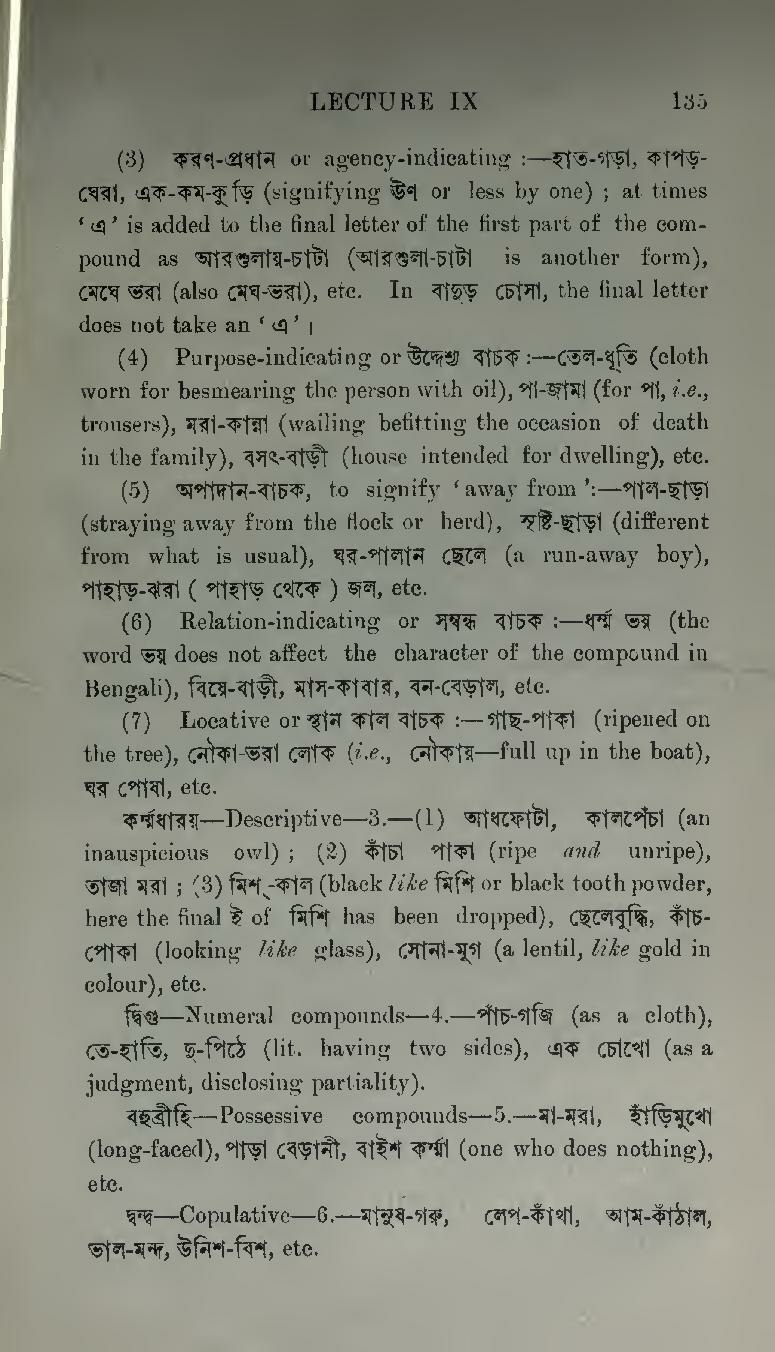(3) করণ-প্রধান or agency-indicating:—হাত-গড়া, কাপড়-ঘেরা, এক-কম-কুড়ি (signifying ঊণ or less by one); at times 'এ' is added to the final letter of the first part of the compound as আরশুলায়-চাটা (আরশুলা-চাটা is another form), মেঘে ভরা (also মেঘ-ভরা), etc. In বাদুড় চোসা, the final letter does not take an 'এ'৷
(4) Purpose-indicating or উদ্দেশ্য বাচক:—তেল-ধুতি (cloth worn for besmearing the person with oil), পা-জামা (for পা, i.e., trousers), মরা-কান্না (wailing befitting the occasion of death in the family), বসৎ-বাড়ী (house intended for dwelling), etc.
(5) অপাদান-বাচক, to signify 'away from':—পাল-ছাড়া (straying away from the flock or herd), সৃষ্টি-ছাড়া (different from what is usual), ঘর-পালান ছেলে (a run-away boy), পাহাড়-ঝরা (পাহাড় থেকে) জল, etc.
(6) Relation-indicating or সম্বন্ধ বাচক:—ধর্ম্ম ভয় (the word ভয় does not affect the character of the compound in Bengali), বিয়ে-বাড়ী, মাস-কাবার, বন-বেড়াল, etc.
(7) Locative or স্থান কাল বাচক:—গাছ-পাকা (ripened on the tree), নৌকা-ভরা লোক (i.e., নৌকায়—full up in the boat), ঘর পোষা, etc.
কর্ম্মধারয়—Descriptive—3.—(1) আধফোটা, কালপেঁচা (an inauspicious owl); (2) কাঁচা পাকা (ripe and unripe), তাজা মরা; (3) মিশ্-কাল (black like মিশি or black tooth powder, here the final ই of মিশি has been dropped), ছেলেবুদ্ধি, কাঁচ-পোকা (looking like glass), সোনা-মুগ (a lentil, like gold in colour), etc.
দ্বিগু—Numeral compounds—4.—পাঁচ-গজি (as a cloth), তে-হাতি, দু-পিঠে (lit. having two sides), এক চোখো (as a judgment, disclosing partiality).
বহুব্রীহি—Possessive compounds—5.—মা-মরা, হাঁড়িমুখো (long-faced), পাড়া বেড়ানী, বাইশ কর্ম্মা (one who does nothing), etc.
দ্বন্দ্ব—Copulative—6.—মানুষ-গরু, লেপ-কাঁথা, আম-কাঁঠাল, ভাল-মন্দ, উনিশ-বিশ, etc.
